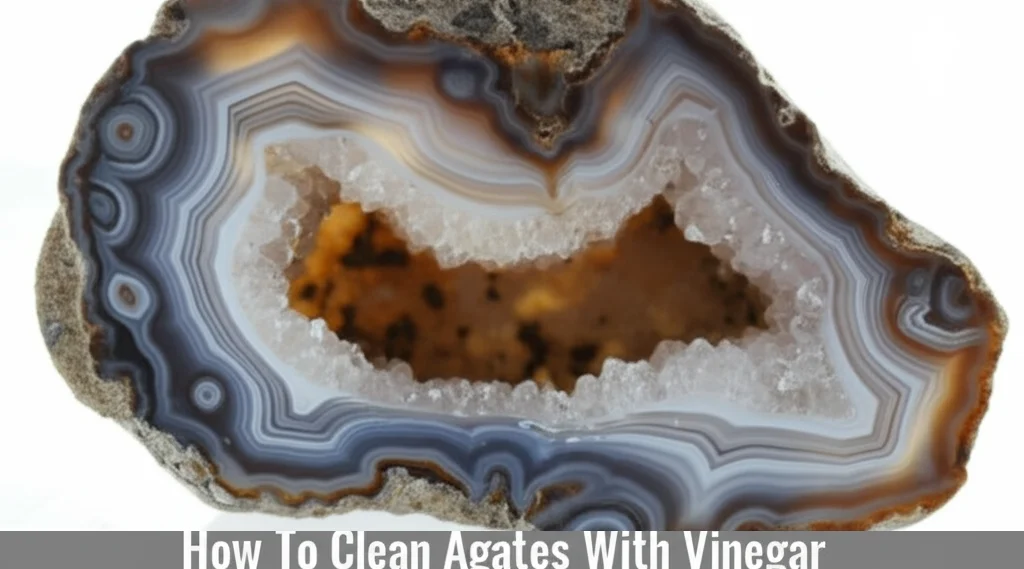· Gemstones & Minerals · 6 min read
How To Clean Agates With Vinegar

Cleaning Agates: A Vinegar Solution
Have you ever wondered how to bring back the vibrant colors of your agates? Agates, beautiful and unique gemstones, can become dull and dirty over time. Dirt, dust, and mineral buildup can obscure their natural patterns. Fortunately, cleaning agates doesn’t require expensive solutions or complicated processes.
This article will show you how to effectively clean agates with vinegar, a simple and readily available household item. We’ll cover everything from preparing your agate to the final polish, ensuring your stones look their best.
Takeaway:
- Vinegar is a safe and effective cleaner for agates.
- Soaking and gentle scrubbing are key to removing dirt and buildup.
- Rinsing thoroughly and drying completely prevents damage.
Can you clean agates with vinegar?
Yes, you can! Vinegar’s mild acidity gently dissolves dirt and mineral deposits without harming the agate. This makes it a perfect, natural cleaning solution for these beautiful stones.
Why Use Vinegar to Clean Agates?
Vinegar is a fantastic choice for cleaning agates because of its gentle yet effective cleaning power. Unlike harsh chemicals, vinegar won’t damage the stone’s surface or alter its colors. It’s a mild acid that dissolves dirt, grime, and mineral deposits that accumulate on agates. This is especially helpful for agates found near mineral-rich environments.
Using vinegar is also a cost-effective and environmentally friendly option. You likely already have it in your kitchen, eliminating the need to purchase specialized cleaning products. Plus, it’s a biodegradable solution, making it a responsible choice for cleaning your gemstones. Consider using white distilled vinegar for the best results, as it doesn’t contain any added dyes or fragrances.
Preparing Your Agate for Cleaning
Before you start cleaning, proper preparation is essential. First, examine your agate to identify any loose dirt or debris. Use a soft brush, like a toothbrush, to gently remove any visible particles. This prevents scratching the agate during the cleaning process.
Next, assess the agate’s condition. If it’s heavily soiled, a longer soaking time will be necessary. For agates with intricate patterns or crevices, pay extra attention to ensure the vinegar solution reaches all areas. Remember to handle your agate with care, as some varieties can be fragile. You can find more information on gemstone care at https://beacleaner.com/how-to-clean-luxury-vinyl-plank-flooring/.
The Vinegar Cleaning Process: Step-by-Step
Now, let’s get to the cleaning process! You’ll need white distilled vinegar, a small bowl or container, soft toothbrush, and clean water. Start by diluting the vinegar with an equal amount of water. This creates a gentle cleaning solution that’s effective yet safe for your agate.
- Soaking: Place your agate in the vinegar solution and let it soak for at least 30 minutes. For heavily soiled agates, you can soak them overnight.
- Scrubbing: After soaking, gently scrub the agate with a soft toothbrush. Pay attention to any crevices or areas with stubborn dirt.
- Rinsing: Thoroughly rinse the agate under clean, lukewarm water. Ensure all traces of vinegar are removed.
- Drying: Pat the agate dry with a soft, lint-free cloth. Allow it to air dry completely before handling or displaying it.
Dealing with Stubborn Stains on Agates
Sometimes, agates may have stubborn stains that require extra attention. For these cases, you can increase the vinegar concentration slightly. Try using a solution of two parts vinegar to one part water. Apply this stronger solution directly to the stain and let it sit for a few minutes before gently scrubbing.
If the stain persists, you can create a paste of baking soda and vinegar. Apply the paste to the stain, let it sit for 10-15 minutes, and then gently scrub. Baking soda acts as a mild abrasive, helping to lift the stain without damaging the agate. Always test any cleaning solution on a small, inconspicuous area of the agate first to ensure it doesn’t cause any discoloration. You might also find helpful tips on removing residue from other surfaces at https://beacleaner.com/how-to-remove-baking-soda-residue-from-carpet/.
Polishing Your Agate After Cleaning
After cleaning, polishing your agate can restore its shine and enhance its natural beauty. You can use a soft cloth to buff the agate, creating a polished finish. For a deeper polish, consider using a specialized gemstone polishing cloth. These cloths are designed to remove minor scratches and bring out the agate’s luster.
Alternatively, you can use a small amount of mineral oil to polish the agate. Apply a few drops of mineral oil to a soft cloth and gently rub it onto the agate’s surface. This will enhance the colors and create a beautiful, glossy finish. Remember to wipe off any excess oil with a clean cloth. Maintaining the shine of your agate is important, and you can learn more about floor polishing techniques at https://beacleaner.com/how-to-clean-hardwood-floors-with-vinegar/.
Agate Types and Cleaning Considerations
Different types of agates may require slightly different cleaning approaches. For example, fire agate, known for its iridescent flashes, is more delicate and requires extra care. Avoid harsh scrubbing and prolonged soaking for fire agate. Instead, use a very diluted vinegar solution and a gentle touch.
Moss agate, with its dendritic inclusions, can trap dirt within its patterns. Use a soft brush to carefully clean these inclusions, ensuring you don’t damage the delicate moss-like structures. For banded agates, pay attention to the grooves between the bands, as these areas tend to accumulate dirt. Always research the specific type of agate you have to determine the best cleaning method.
Frequently Asked Questions (FAQ)
Q: Is vinegar safe for all types of agates?
A: Generally, yes. However, more delicate agates like fire agate benefit from a highly diluted vinegar solution and gentle handling. Always test on an inconspicuous area first.
Q: How often should I clean my agates?
A: Clean your agates as needed, typically every few months or when they appear dirty. Regular cleaning prevents buildup and maintains their beauty.
Q: Can I use other acids besides vinegar?
A: It’s best to stick with vinegar. Stronger acids can damage the agate. Vinegar provides a safe and effective cleaning solution.
Q: What if the vinegar doesn’t remove all the dirt?
A: Try a paste of baking soda and vinegar, or increase the soaking time. For very stubborn dirt, consult a professional gemstone cleaner.
Q: Will vinegar affect the color of my agate?
A: No, vinegar is unlikely to affect the color of your agate. However, always test on a small area first to be sure.
Conclusion
Cleaning agates with vinegar is a simple, effective, and affordable way to restore their natural beauty. By following the steps outlined in this guide, you can safely remove dirt, grime, and mineral deposits, revealing the vibrant colors and unique patterns of your stones. Remember to handle your agates with care, use a gentle cleaning solution, and polish them after cleaning to maintain their shine. With a little effort, your agates will continue to sparkle for years to come. If you’re looking for more cleaning solutions for different surfaces, check out our guide on https://beacleaner.com/how-to-clean-bathroom-floor-without-mop/.




